In And Out The Window
Fluxus-Plus Museum, Potsdam 2010

Alison Knowles, In And Out The Window, Fluxus-Plus Museum, Potsdam, 2010
Alison Knowles
From: “Alison Knowles”
To: “Joshua Selman”
Subject: Potsdam to Lodz
Date: Fri, 24 Sep 2010 22:05:34 -0400
Even though these events took place back to back in June and in another country Artist Organized Art was in full flower. AOA was present first of all in Potsdam where I had a two person exhibit with my friend Ann Noel who was for years partner to Emmett Williams. Our show was titled ‘In And Out The Window.’ I provided the windows, 4X8 foot open frames to walk through that had hangings of found objects on strings to be examined and sounded as one passed through in an leparello or accordion style installation that diagonaled through the huge factory space under vaulted ceiling with skylights.
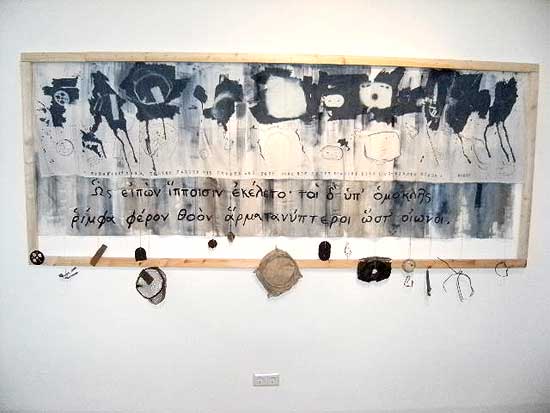
Alison Knowles “Illiad Oddities” found object panel with Greek text concerning voyages,
cyanotype and Homer’s text by hand, 135×280 cm. In And Out The Window, Potsdam 2010
Ann’s work is straightforward art, framed and hanging on the wall. You could just stand there and admire beautifully organized diary panels in full color, really large. The painting consisted of what people were saying to each other on a given day. Each speaker had a different color strip with letters in english in black. It was intermedia and very fine, to read a painting. A key listed the speakers and the works covered three walls. She also did a performance cooking up something totally inedible but fun to see and smell. Some ate it but the museum (the Fluxus+ Museum in Potsdam) was very crowded at the opening. The director Heinrich Liman seemed very pleased with the transformation of his cement manufacturing company factories into one huge museum on the outskirts of Berlin. It had been his dream that he would do this when he retired. One could sit outside the cafeteria of the museum and feel fresh spring air over cold wine. I wanted to see more of him.
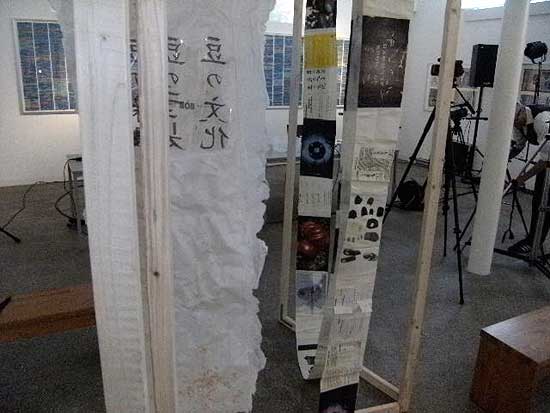
Alison Knowles, In And Out The Window exhibition detail,
diagonal walkthrough environment with xerox and film on laid paper,
Fluxus-Plus Museum, Potsdam 2010
Ann and I trained over to Lodz in Poland to be part of the Lodz Biennale. This was a terrific event titled ‘The Mad Hatters Tea Party’ which she curated with Ryszard Wasko. I have known him for some years as we all have and knew this would be quite a cup of tea! Fluxus regulars had gathered, including from Europe, Eric Andersen and Ben Patterson. At each serving someone stood up from the table of twelve and did something. There were ten surrounding tables in the huge church hall clustered around our main dining table. I remember Geoff Hendricks changed the color of potatoes to green, Eric passed out quizzical cards, Ben Patterson did some strange actions with ice cream. When my turn came I pulled a bag of red lentils from my bag and threw them in the air aiming at the adjacent tables. We drank wine, enjoyed Ryszard and the show he had up and wished again, I wished I could have seen more of him.

Heinrich Liman, Director in his Fluxus+ t-shirt,
with Fluxus Experience Author, Hannah Higgins and her daughter Nathalie,
In And Out The Window, Potsdam, 2010
Heinrich Liman and Ryszard Wasko survive because they are great people who have made themselves happy by throwing their identity with Fluxus which is today as always a dedicated avant garde if somewhat diminished in numbers.
Please sign up for The Identical Lunch at the MoMA Thursday and Friday of January. That’s my tuna sandwich made to order in the cafeteria at noon. I’ll be there to greet you and take you to the show around the corner one flight up. There will be a formal invite on the internet airing (I like streaming) on Jan. 3 2011.
Alison
–
Ausstellung IN AND OUT THE WINDOW
Alison Knowles, Ann Noël
Ausstellung vom 25.06.- 29.08.2010
Performances Vernissage Freitag, 25. Juni 2010, 19.00 Uhr
IN AND OUT THE WINDOW, der Titel der Ausstellung erinnert an ein Kinderlied, einen Reigentanz. Die Tanzenden reichen sich die Hände, öffnen mit den Armen “Fenster”, nehmen den Nächsten mit. Das Lied endet mit “And see what you can see!” – genau diese Forderung stellt sich in der Ausstellung.
Die amerikanische Künstlerin Alison Knowles zählt zu den Gründungsmitgliedern der Fluxus-Bewegung und erarbeitete zahlreiche Fluxus-Performances wie “The Identical Lunch” (1969) oder “Make a Salad” (1962). Andere ihrer Arbeiten gehören zur Klangkunst oder wurden als Hörspiele konzipiert. In ihrem Werk sucht Alison Knowles die Verbindung zur Natur und deren Wandel. In der jetzigen Ausstellung werden begehbare Rahmen ihre Arbeiten tragen und den Besucher zum Durchschreiten einladen. In der Nachbarschaft gefundene Objekte hängen an Schnüren im Raum. Der ursprüngliche Sinn bleibt wie ein Traum in der Erinnerung. Drei Meter Tuch spannt sich über eine Wand und zeigt Kuriositäten, ganz im Sinne von Fluxus, als das Leben zur Kunst erklärt wurde.
Ann Noël ist eine vielseitige bildende Künstlerin, die sich mehrmals an Performances und Ausstellungen mit Fluxus-Künstlern beteiligt hat. Sie wird in Berlin von der Emerson Galerie und in Zürich von der Galerie & Edition Marlene Frei vertreten. Für die jetzige Ausstellung lässt sie farbige Foto-Collagen mit ausgewählten Papierfundstücken und Texten (Kinderreimen) lebendige Geschichten erzählen. Die Künstlerin präsentiert neue Mix-Media-Arbeiten und farblich übermalte Namenstafeln aus den Texten ihrer Tagebücher 1989-2001 unter dem Titel “CONFLUX II”. Während der Performance am Freitag, 25. Juni 2010 werden 12 kleine Leinwände als “FLUXUS HORS_D´OEUVRES D´ART” fertig gestellt.
In mehr als 40 Jahren kreuzten und trafen sich die Wege der beiden Künstlerinnen immer wieder. Nun zeigen Sie in ihrer gemeinsamen Ausstellung, wie aus künstlerisch verarbeiteten Fundstücken Collagen und Assemblagen werden. Zahlreiche Werke der Beiden sind Teil der Sammlung des museum FLUXUS+ in Potsdam.
Zur Ausstellungseröffnung am Freitag, dem 25.06. um 19.00 Uhr sind die Künstlerinnen anwesend und performen “Fluxus hors d’oeuvres” und “Fluxus with tools”. Für diese Eröffnungsveranstaltung bittet das Museum um einen Kostenbeitrag von 10,- / ermäßigt 6,- Euro. Ein Besuch der Dauerausstellung bis 22.00 Uhr ist in diesem Eintritt enthalten.
Das Museum enthüllt um 21.00 Uhr anlässlich dieser Vernissage die “Hommage à Emmett Williams”; eine beleuchtete Außenwandinstallation. Die “Little Men” vom Fluxus-Künstler Emmett Williams werden von nun an auf der Havelseite des Museums farbenfroh die Besucher der Schiffbauergasse grüßen und in das Museum bitten.
Weitere Informationen unter www.fluxus-plus.de
Wenn Sie keine Newsletter-Informationen des museum FLUXUS+ mehr haben möchten, senden Sie uns bitte ein “abmelden” an info@fluxus-plus.de. Danke
museum FLUXUS+
Schiffbauergasse 4f, 14467 Potsdam
Fon: (0331) 60 10 89 – 22
Fax: (0331) 60 10 89 – 10
info@fluxus-plus.de / www.fluxus-plus.de
On art;
or the law, blindness, and possible gestures of virginity
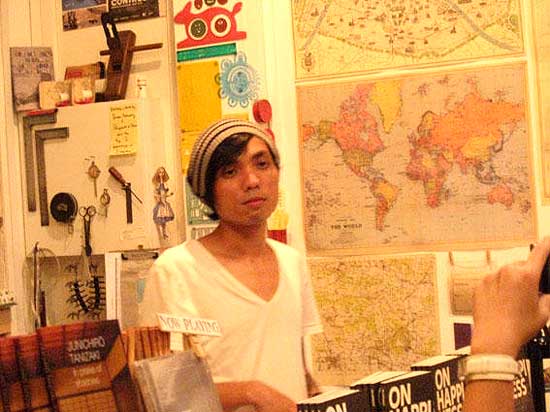
Kenny Png, Writer, Director, Soundscape & Visual Designer of ‘The Boxes’
by Artist Jeremy Fernando
The spectre that haunts every work of art, every attempt at a work of art, is that of originality; of whether what one is attempting to do has already been attempted, or even worse, accomplished. After all, no one wants to be deemed a mere reproducer.
Here, one can hear a trace of an obsession with beginnings, and the fantasy of the original; along with a longing for the aura that surrounds the first, the beginning, and the power it brings with it—of credibility, of authority, of being the source. Perhaps this is why correction fluid has become indispensable in our stationary drawers: as if by writing over a word, a line, a smudge, putting a layer over it, we can cover it up, erase it completely; as if banishing it from sight will equate to banishing its memory, banishing it from memory. The underlying logic is that in order for anything to be important, one has to be the first to do it; more importantly, traces of all others have to be wiped away. In other words, one has to produce; not reproduce.
In some way, this is a hangover of the Enlightenment; specifically with regards to the belief in transcendental Truth(s) and origins. It is this hang-up over the power that comes with being the first—the author—that lends itself to the societal obsession with virginity, with virgins; a desire to be a virginal experience, the virginal experience. Along with this fixation of being a primordial experience comes the notion of absolute knowledge; as if being the first means a mastery of the situation.
At the tail end of March 2009, we heard rumbles of this in the controversy surrounding the Wild Rice—a highly-regarded Singaporean theatre company—production of Oscar Wilde’s The Importance of Being Earnest. The show was given “an advisory rating of ‘16 years and above’ to avoid confusion ‘about its content and underlying messages’ among younger audiences and those who are unfamiliar with the play” by the Media Development Authority of Singapore,1 ostensibly for having an all-male cast. Most people presumed that the MDA rating was due to the foregrounding of gender; which either unveiled the performativity of gender, or even highlighted the alleged homosexual undertones of Wilde’s work. Of course, they completely missed the point. What was at stake was far higher: the primacy of the author. By having an all-male cast, Wild Rice was staking a claim for reading—where the text comes into being in and through its reading.

Brendon Fernandez in staged reading of ‘The Boxes’
For, it is not difficult to hear an echo of author in authority; as if the writer of the situation can play at being God—all-seeing, and in full control. The trouble with authority is that it is always already illegitimate. For, if something is legitimate, access to it would be open to everyone—governed by the Law. It is only when something is illegitimate that the authority of a person is required to enact it. For instance, a death-sentence can only be pardoned by the authority of the sovereign. In doing so (s)he is going against the legal system which sentenced that person to death; the same legal system that upholds her/ his very sovereignty. In other words, authority is the very undoing of the Law. To compound matters, any enactment of the law requires an executor of that law; in other words, a figure of authority. Hence, authority is both authored by the law, and its very author at the same moment—the hinge on which it operates, and also its very finitude. However, a foregrounding of its illegitimacy would not only shatter the illusion, but also bring about the collapse of the entire system. The very source of that authority though—of why someone has authority, and more than that why we grant authority to someone which necessitates our subjectification to that figure who only has the authority due to our self-subjectification—remains outside of reason, remains unknown; remains a secret.
In some way, the question that remains sounds paradoxical: if we posit the importance of protecting the secret (lest everything comes crumbling down), how can it be a secret if everyone already knows what the secret is?

Jo Tan & Rebecca Lee in staged reading of ‘The Boxes’
Here perhaps, we need to turn to the very notion of secrets themselves. And to do so, let us momentarily draw upon an old tale. When Isis poisoned Ra, she promised him the antidote in exchange for his secret name, which was the source of all his power. And when he whispered it into her heart, she felt herself filled with all the knowledge and wisdom of Ra; all the power that came with his name—Amen-Ra. However, it was not as if no one else knew it; one would have been hard-pressed to find someone who didn’t know the fact that he is Ra. What this shows is that secrets rarely lie in the content (after all, Amen is merely an affirmation), but in knowing that something is secret, in the gesture of acknowledging that the secret is a secret, that he is indeed Ra.
Perhaps this is the lesson of Andy Warhol. It was not so much the reproduction itself that is the art, but the very gesture of recognizing the objects to be reproduced. There is nothing to an old pair of shoes lying around; it was van Gogh’s realization of the possibilities in the singularity of the situation—those very shoes in that moment—that momentarily elevates it to the realm of art. In this sense, one can posit that both Warhol and van Gogh were authors at that moment of recognition: through their respective media, both of them create a singularity by arresting a particular moment in time. And since it is a singular moment, it is in some sense always also an original gesture; one that has never happened before, one that is also potentially non-repeatable. In this manner, one can posit that the artistic gesture is the reification of time itself: the concretization of a moment through a media, as if that moment was real; in other words, the authoring of a moment.

Audience peering through Png’s Plugs
The irony though, is that every gesture is always already a reproduced gesture. After all, regardless of media, one is capturing a moment, and more precisely, a moment that has passed. In this sense, all art is a reconstitution of memory. This is not to say that every act of memory is art; or that every attempt to capture memory is art. Far from it.
Perhaps here, one might consider the status of forgetting. Since forgetting happens to one, it is both strictly speaking exterior to one’s cognition, and also beyond one’s control. Hence, there is absolutely no reason to believe that each act of memory might not bring with it forgetting. By extension, there is no possibility of knowing if each act of remembering recalls the same memory. And it is precisely the impossibility of knowing—this unknowability that haunts all knowledge—that gives each situation the possibility of singularity. Hence, singularity is always already external to the subject; it is the very finitude of subjectivity.
This suggests that singularity, originality—or dare one say the artistic gesture—is found not in a completed, accomplished, work, but rather in the potential forgetting in that work. In this sense, art is the foregrounding of the possibility of forgetting. And since it is impossible to foreground what one cannot know, this suggests that art is always already in its praxis, and more than that, it is always already only to come.
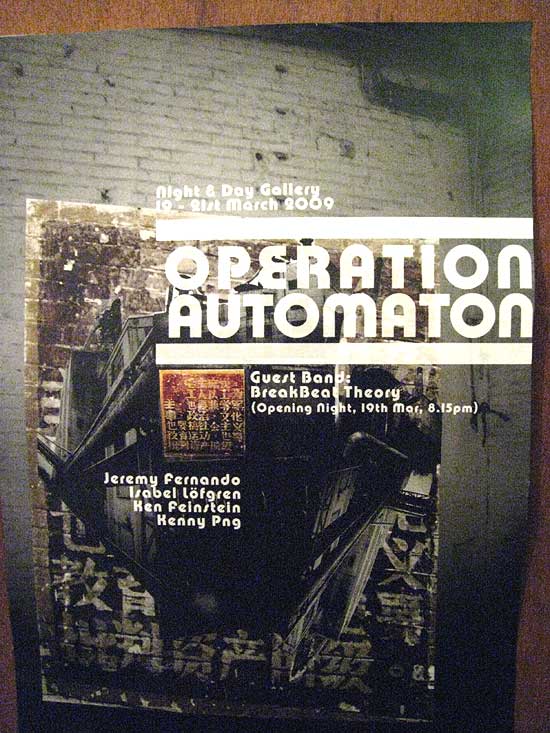
Poster for Operation Automaton
Night and Day Gallery: Singapore (19-21 March, 2009)
From 19 till 21 March 2009—about the same time as the controversy over Earnest—Isabel Löfgren, Kenneth Feinstein, Kenny Png, and Jeremy Fernando attempted to think the notion of art as praxis, think the relationality of art and the artist, through different media—sketchings (Löfgren), video (Feinstein), photography (Png), and painting (Fernando)—in an exhibition at Night & Day Gallery entitled ‘Operation Automaton.‘ Löfgren’s work involved the repeated drawing of a Möbius strip, until such point where the body automatically takes over, and cognition fades into the background. Feinstein’s repeated showing of train-tracks and public housing allowed the viewer to open the relationality between the two seemingly related, but yet unrelated, objects of everyday life. The individual photographs in Png’s piece were minute, and situated within electric-plugs: whomever wanted to catch a glimpse of them had to squint through the plug; calling into question the notion of seeing, and shifting the position of the viewer from neutral onlooker to active witness. And in Fernando’s piece, three blank canvasses were left next to headphones: people were free to paint whilst listening to the vastly different genres of music playing on the respective headphones. In various ways, not only did the exhibition foreground the viewer and the work in relation to art, it calls attention to the gap between the artist and the art itself.
This is an approach to art that acknowledges that part of art always lies outside the person; that at best can only be glimpsed momentarily. This is art in the precise sense of a craft at its highest level; where it consumes the practitioner, often in ways which are exterior to one’s cognitive ability. In this sense, art remains invisible to one; at best, it expresses itself through one.
If one can never be sure of the status of one’s act—whether it is reproduced through memory, or whether it is a new act due to a forgetting—every act is then both (n)either a first (n)or a reproduction. By extension, each time one performs an act, one is both neither a virgin and always already virginal. This is also a foregrounding of the illegitimacy of authority; one cannot legitimately say whether something is art or not. In other words, any judgement is based on nothing except the praxis of judging itself; where one cannot have any metaphysical comfort, or certainly, that one is correct (or wrong). Hence, art lies in its praxis, in each attempt at making something, doing something, practicing one’s craft; at best, all that can be said is that art is a gesture towards the possibility of art. More than that, whether something ever reaches the realm of art—a reproduction that is not just a reproduction—or remains just another reproduction—not that there is any logical difference between the two—always already remains a secret from us, perhaps until it happens. And when it does, its reason might still remain unknown to us; which means that all attempts to reproduce the gesture might always only remain a reproduction.
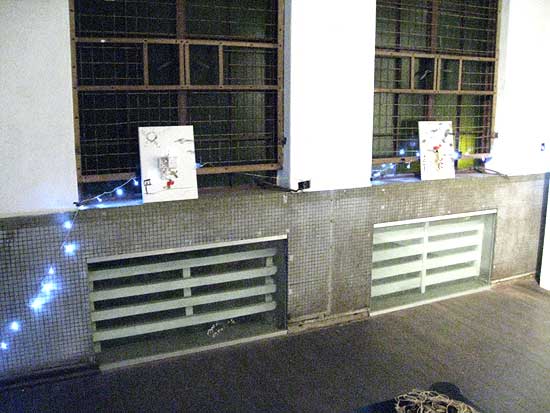
Kenny Png, ‘Plugs’
Mixed Media, Operation Automation
And on 23 July, 2010, it was this risk that Brendon Fernandez—who played Algernon Moncrieff in the Wild Rice production—along with Rebecca Lee and Jo Tan ran when they put on a staged reading of Png’s play ‘The Boxes’ at Books Actually.2 Even though every performance of a play is also its re-reading, and potential re-writing, what was unique about this occasion was not the absolute absence of the author from the rehearsal process (that is more than common), but the fact that Png was absent even as he was credited as the director of the said reading. To complicate matters, Png crafted both the soundtrack and video backdrop in a divorced setting from his actors (all of whom rehearsed separately as well). On 23 July, at 7.30pm—completely blind to the preparations of the others—they began. What was foregrounded was the primacy of the text, and the reading of the text: in the improvisation that was needed for the actors, music, and video, to speak to and with each other, Png, Lee, Tan, and Fernandez, had to be negotiating not only with the others, but also the text. Hence, it was a performance not just of ‘The Boxes’ but of reading itself; one that could never be sure of its status as reading, of whether it was a unique performance, or merely the re-uttering of the words that were printed in the book; one that highlighted the lack of grund in all reading, all performance, all attempts at art.
In other words, art is nothing more than a gesture. And more than that, since art always already remains potentially exterior to the person, there are no artists; there is only the possibility of the gesture.
One that is made in blindness to everything but the possibility of art itself.
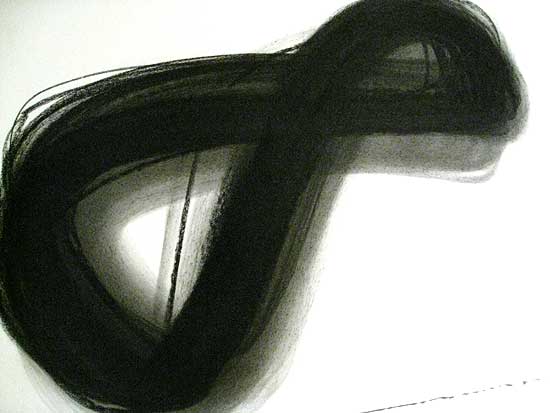
Isabel Löfgren, ‘Mobius’
from Automated Sketchings, Operation Automaton
_____
Jeremy Fernando is the Jean Baudrillard Fellow at the European Graduate School. He works in the intersections of literature, philosophy, and the media; and is the author of Reflections on (T)error, Reading Blindly, and The Suicide Bomber; and her gift of death. Exploring different media has led him to film, music, and installation art; and his work has been exhibited in Vienna, Hong Kong, Seoul, and Singapore. He is the editor of the thematic magazine One Imperative, and is also a Research Fellow at the Centre for Liberal Arts and Social Sciences, Nanyang Technological University.
1 http://www.channelnewsasia.com/stories/entertainmentfeatures/view/414049/1/.html
2 Kenny Png. ‘The Boxes’ in Jeremy Fernando & Kenny Png. On Happiness. Singapore: Math Paper Press, 14-35.
Books Actually is an independent book store which can be found at 86A Club St, Singapore. The owners, Karen Wai and Kenny Leck, are renown both for supporting the local arts scene and, more importantly, for having impeccable taste when it comes to literature. (For more information please see http://booksactually.com/)










